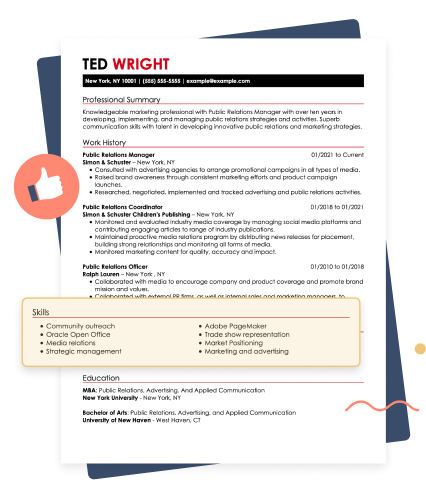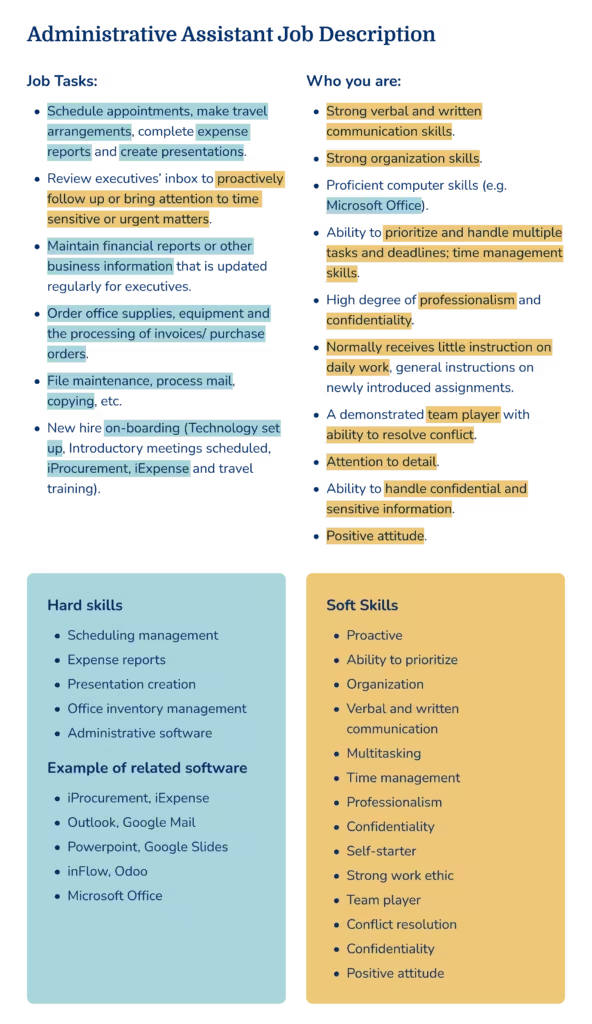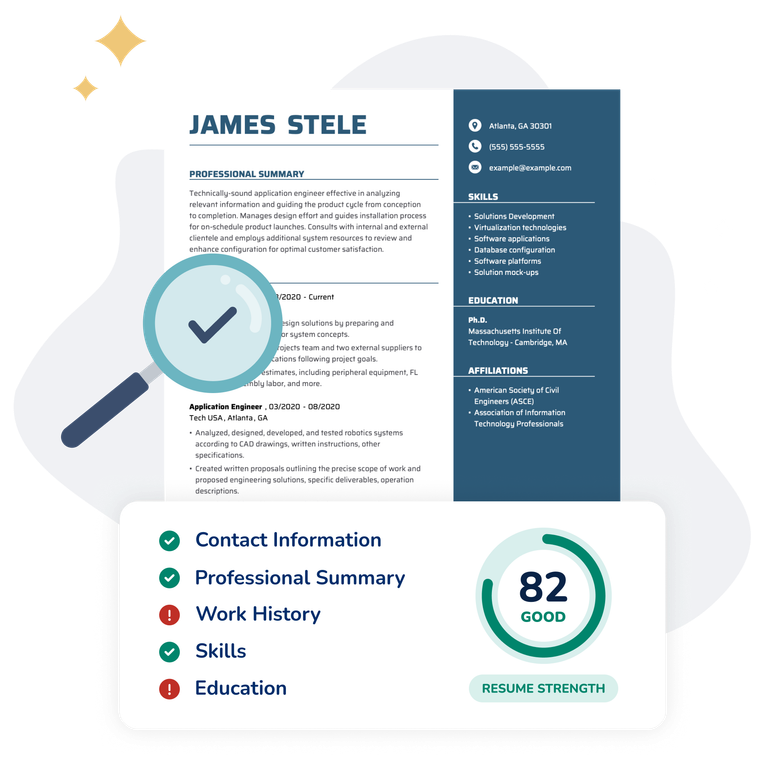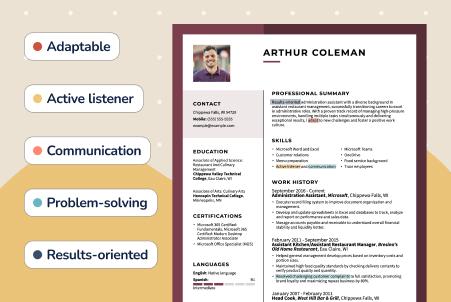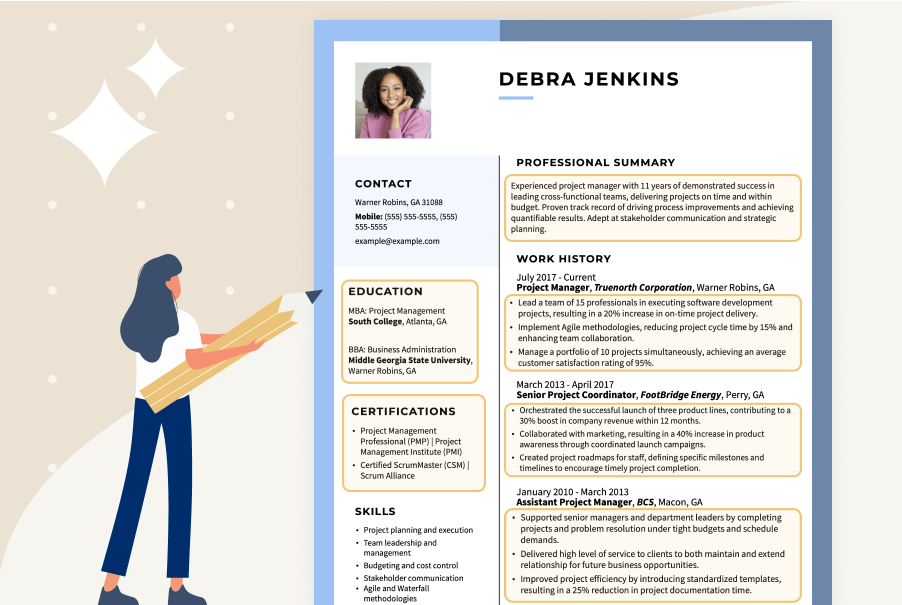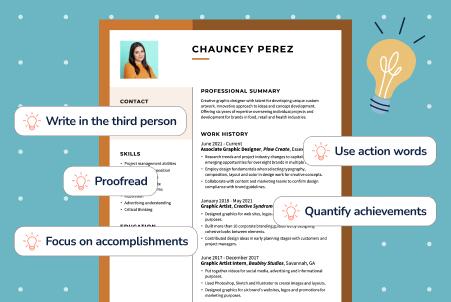Essential Resume Skills: Examples for Any Job

Our customers have been hired at: *Foot Note
You have the skills necessary for landing your next job, but it’s important to effectively showcase them in order to get notice and land that interview first. A winning resume highlights the abilities most relevant to the job, instantly capturing the attention of hiring managers.
We’ve curated an up-to-date guide featuring the top hard and soft skills to include on your resume in 2025, ensuring you make a lasting impression.
Best Skills for a Resume
Our research into resume skills shows that the following are the most in-demand skills in resumes today throughout all industries.
However, it’s important to note that the right skills for your resume will depend on both your experience and the employer’s requirements.
See if any of these apply to you and set them aside to get your skill list started:
- Interpersonal skills: Employers value candidates who can build strong working relationships. Interpersonal skills allow you to connect with others, collaborate effectively, and navigate team dynamics, which is essential in today’s workplace.
- Adaptability: A rapidly changing job market needs candidates who can handle ever-shifting demands and continue to excel at their jobs. Your ability to adapt to new surroundings is a plus in your resume skills section. Add examples of how you’ve been able to go with the flow and adapt to what companies need.
- Digital literacy and AI proficiency: Today’s employers expect candidates to be comfortable with technology. Knowing how to use digital tools, safeguard your privacy, and navigate basic computer systems is essential. With AI transforming nearly every industry, showing how you’ve used it to improve workflow or spark innovation can set you apart.
- Attention to detail: Catching mistakes and fixing them, ensuring all your job duties are handled correctly and delivering accurate, high-quality work are all hallmarks of great employees—and all stem from great attention to detail, making it a good skill to put on a resume.
- Time and workflow management: Employers seek candidates who can accomplish tasks efficiently and reliably. Strong time management skills show that you’re committed to your responsibilities, can meet deadlines, and handle multiple tasks without losing focus.
- Strong work ethic: How you approach your work is as important as the technical skills you add to your skills section. Employers will always appreciate a work ethic that shows you’re dedicated and committed to the job.
- Customer-centric thinking: Great customer service skills mean putting client and user needs first—whether you’re solving a problem, delivering a product, or shaping a service experience. On your resume, highlight how you’ve listened to feedback, built trust, or helped improve customer satisfaction to show your impact.
- Innovation and creativity: Companies value employees who can think creatively and bring innovative ideas to the table. Whether you’ve improved a process, introduced a new way of doing things, or contributed to a creative project, show it on your resume. Highlight moments where your ideas made a difference or helped your team solve a tough challenge.
- Project and operations management: Advancing your career relies heavily on showing you can oversee and manage work projects. Be sure to mention project management skills and any familiarity with Agile methodologies, such as Scrum, and project management software, such as Trello and Zoho, in the skills section of your resume.
- Cross-functional collaboration: Work today rarely happens in a silo. Employers look for candidates who can collaborate across teams, departments, and roles to get things done. On your resume, show how you’ve worked with people from different backgrounds or functions to solve problems, launch projects, or meet shared goals.
Need help creating your skills section? Our AI Resume Skills Generator instantly builds a skills list tailored to your job title!
AI Resume Skills Generator

Hard Skills vs Soft Skills
When writing your resume, it is best practice to list six to eight key skills, both soft and hard. This strategy enables you to showcase a well-rounded skill set that demonstrates your ability to perform job duties and integrate into the company culture. Here are the differences:
Hard skills
Hard skills are the technical abilities you’ve gained through training, education, or hands-on experience. They’re specific to your role or industry and show employers you have what it takes to do the job. These can include software, tools, or specialized methods essential for performing key tasks. For example:
- Data analysis
- Programming language (e.g. Python or Java)
- Graphic design software (e.g. Adobe Photoshop or Illustrator)
- Project management tools (e.g. Asana or Trello)
- Foreign language proficiency (e.g. Spanish or Mandarin)
Soft skills
Soft skills are the personal qualities and interpersonal abilities that shape how you approach work and interact with others. They can be natural traits or skills you develop over time, and they play a key role in a functional and positive company culture. For example:
- Time management
- Critical thinking
- Conflict resolution
- Self-motivation
- Emotional intelligence
Top 10 Resume Hard Skill Examples for Popular Jobs
1. Data analysis
The world runs on data and the ability to analyze it, draw intelligent conclusions, and use your findings to improve business operations. Essential related resume skills include:
- Data visualization
- Programming
- Skills statistics
- Knowledge programming tools
- MATLAB

2. Cybersecurity
Nothing is worse for a business than stolen data, and cybersecurity professionals are the first vital line of defense against hackers. In addition to cybersecurity certifications, other highly sought-after computer skills for resumes include:
- Knowledge of security across different platforms
- Computer forensics skills
- Risk identification and management
- Scripting
- DevOps

Related jobs:
3. Programming
Programming skills are valuable for working with websites, internal networks, and mobile apps. Feature your knowledge of specific programming languages and other related skills in your resume skills section, such as:
- Java
- HTML5
- Cloud computing
- Web development
- Object-oriented programming (OOP)

Related jobs:
4. Marketing
Marketing helps businesses reach out to consumers and increase sales, subscriptions, and overall engagement. Related job skills for a resume include:
- Search engine optimization (SEO)
- Search engine marketing (SEM)
- Email and social media marketing
- Copywriting
- Google Analytics

5. Accounting
Handling financial matters is an essential part of any business, and the ability to parse numbers, analyze budgets and provide detailed, accurate account management is a crucial component of finance. Skills to add to a resume in this field include:
- Microsoft Excel
- Big data analysis
- QuickBooks
- Tally
- Financial statements

Related jobs:
6. Design
Companies have a high need for polished design work, from multimedia to website layouts. Important skills to put on a resume for this type of job include:
- Adobe Creative Suite
- UI design
- UX wireframing
- Typography and layout design
- HTML/CSS

Related jobs:
7. Writing
Even in today’s tech-heavy world, good writing skills are still necessary for communication, executing marketing campaigns, assembling documentation, and creating presentations. Good skills to put on a resume for this ability include:
- Content writing
- Editing
- Business report and proposal writing
- Creative storytelling
- Planning and outlining

Related jobs:
8. Cloud computing
Jobs in cloud computing will only increase as more companies move important data to the cloud or use it to manage employee tasks. Related skills to add to a resume for this career include:
- Cloud architecture
- Networking
- Cloud middleware technologies
- Data management
- Application programmer interfaces (APIs)

Related jobs:
9. Specialized machinery
Whether licensed to drive large transport vehicles or operate heavy equipment, having training or certification in machinery operation is something you can add to the skills section of a resume to open doors to jobs in many industries, from inventory to construction. These include:
- Forklift operation
- Backhoe
- Certified Equipment Manager (CEM)
- Loaders operation
- Physical stamina and strength

10. Foreign languages
As the global economy becomes more integrated, employers increasingly need multilingual employees. People who speak more than one language also often have better memory and multitasking ability. Make sure to highlight your multilingual abilities in your resume skills section, such as:
- Spanish
- Italian
- Japanese
- German
- French

Related jobs:
Check out our full library of resume examples to see how other job seekers across industries showcase their skill set.
Top 10 Soft Skill Examples for a Resume
Soft skills are highly valuable to employers and can improve job performance while increasing your career advancement opportunities. The demand for soft skills is expected to continue to grow as the workplace evolves. These are the top 10 sought-after soft skills to include in your resume:
1. Communication
Employers count good communication skills as a prerequisite for most jobs, whether assisting a customer or interacting with your team members. In your resume, include achievements that involve interacting well with others and stress “verbal and written communication” in your resume skills section.

2. Teamwork
Even if you’re working remotely, collaborating with and supporting other team members remains an essential soft skill for your resume. Ensure you describe yourself as a team member by providing examples of how you’ve successfully worked alongside others and contributed to the successful operations of your team.

3. Problem-solving
Another soft skill for your resume that never goes out of style is solving problems: using creative thinking, experience, and resourcefulness to overcome obstacles. Show off problem-solving skills in your resume’s work history section by sharing accomplishments in which you had to work through a challenge.

4. Empathy
Understanding and sharing the feelings of others helps build strong workplace relationships. Empathy improves communication, teamwork, and customer service by fostering respect and collaboration.

5. Leadership
One of the surest ways to advance in your career is to demonstrate strong leadership skills. Professionals with a talent for leading others toward success, whether by taking charge of a project, mentoring junior employees, or providing positive direction for a team or company, are highly valuable across industries.

6. Dependability
Employers need team members they can count on to consistently deliver quality work and meet deadlines. Demonstrating dependability shows you’re responsible and trustworthy—qualities that make you a valuable asset.

7. Active listening
Focusing when interacting with and getting instructions from others will help you better connect with colleagues and clients and more quickly pinpoint work problems and solutions. Show that you’re present by including this ability in your job skills list.

8. Critical thinking
Employers don’t want automatons, they want employees who can make reasoned choices and adjustments depending on the situation, making this a great soft skill for your resume. Show your critical thinking skills by giving examples of times when you had to use good judgment to complete a project, improve a process, or achieve the desired result.

9. Conflict management
Let’s face it; not everything will run smoothly at work all the time. When friction arises with co-workers, a boss, between departments or clients, an even-keeled, calm and goal-oriented approach is a useful asset. Essential skills for a resume that fall under the conflict management category include facilitation, mediation, and active listening.

10. Organization
Keeping a firm handle on all your duties and turning chaos into order is a crucial job skill, especially for positions requiring coordinating large amounts of paperwork or data or managing large events or groups. Display your organizational skills by calling out any experiences you have in which your ability to organize made a difference.

What Are Transferable Skills?
Transferable skills are skills and abilities that you acquire in one job or situation that can be applied to another job or situation. These skills are considered valuable to employers because they can be used across different industries or job functions.
Some examples of transferable skills include:
- Communication
- Teamwork
- Problem-solving
- Critical thinking
- Time management
- Leadership
- Adaptability
- Customer service
Transferable skills are essential in today's job market, where many people change careers multiple times throughout their working lives. Having a strong set of transferable skills can make it easier to transition between jobs and industries. They can also make you a more attractive job candidate, as employers value employees who can bring diverse skills and experiences to their organization.
Top Resume Skills for Popular Industries
Accounting skills
Soft skills:
- Attention to detail
- Organization
- Time management skills
- Critical thinking
Hard skills:
- CRM systems
- Knowledge of tax regulations
- Proficiency with specific software (e.g., Intuit QuickBooks Online, FreshBooks)
- Financial reporting and budgeting
Business operations skills
Soft skills:
- Communication
- Motivational skills
- Organizational abilities
- Problem-solving
Hard skills:
- Project management
- Negotiation skills
- Compliance and oversight
- Financial analysis and reporting
Computer software skills
Hard skills:
- AWS
- Project management
- Knowledge of programming languages (e.g., Java, Python)
- Software testing and debugging
Soft skills:
- Problem-solving
- Written and verbal communication
- Attention to detail
- Adaptability
Customer service skills
Soft skills:
- Communication
- Flexibility
- Positivity
- Active listening skills
Hard skills:
- Product/service knowledge
- Point-of-sale (POS) systems
- Customer management
- Digital awareness
Data administration skills
Soft skills:
- Attention to detail
- Problem-solving
- Communication
- Collaboration
Hard skills:
- Data collection and management
- Knowledge of database applications (e.g., DB2)
- Troubleshooting
- Database administration certification (e.g., Oracle MySQL)
Finance skills
Soft skills:
- Analytical ability
- Communication
- Attention to detail
- Problem-solving
Hard skills:
- Financial reporting
- Data collection and management
- Proficiency in accounting software (e.g., QuickBooks)
- Project management
Fitness and nutrition skills
Soft skills:
- Motivation
- Patience
- Communication skills
- Empathy
Hard skills:
- Personal training techniques
- Knowledge of physiology
- Knowledge/certification in dietetics
- Assessing nutritional needs
Food service skills
Soft skills:
- Multitasking
- Teamwork
- Communication
- Flexibility
Hard skills:
- Customer service
- Menu memorization
- Knowledge of food safety standards/procedures
- Inventory management
Healthcare support skills
Soft skills:
- Excellent communication
- Attention to detail
- Empathy
- Adaptability
Hard skills:
- Analyzing medical information and data
- Certification in first aid/CPR
- Specialized medical knowledge (e.g., occupational therapy)
- Knowledge of regulatory practices
Hospitality skills
Soft skills:
- Communication
- Multitasking
- Conflict resolution
- Teamwork
Hard skills:
- Customer service
- Human resource management
- Maintenance and cleaning
- Marketing skills
Human resources skills
Soft skills:
- Teamwork
- Communication
- Multitasking
- Time management
Hard skills:
- Performance management
- Legal knowledge
- Project management
- Knowledge of HR-related software (e.g., BambooHR, OpenHR)
Information technology skills
Soft skills:
- Organizational skills
- Problem-solving
- Attention to detail
- Critical thinking
Hard skills:
- Coding skills
- Computer networking
- Project management
- Troubleshooting
Inventory management skills
Soft skills:
- Verbal and written communication
- Organizational skills
- Problem-solving
- Teamwork
Hard skills:
- Inventory control
- Warehouse operations
- Supply chain management
- Knowledge of inventory software (e.g., NetSuite)
Marketing skills
Soft skills:
- Organizational skills
- Excellent time management
- Verbal and written communication
- Collaboration
Hard skills:
- Copywriting
- Social media
- Project and campaign management
- Data analysis
Medical skills
Soft skills:
- Problem-solving
- Empathy
- Flexibility
- Interpersonal skills
Hard skills:
- Patient preparation
- Taking vital signs
- Administration
- Expertise in specific medical fields (e.g., phlebotomy)
Nursing skills
Soft skills:
- Empathy
- Time management
- Communication
- Strong work ethic
Hard skills:
- Basic life support
- Patient records maintenance
- Critical care nursing
- EHR proficiency
Production skills
Soft skills:
- Dependability
- Strong work ethic
- Teamwork
- Attention to detail
Hard skills:
- Quality management
- Computer-automated technologies
- Knowledge of continuous improvement processes
- Internal purchasing
Sales skills
Soft skills:
- Communication
- Active listening
- Problem-solving
- Time management
Hard skills:
- Product knowledge
- Negotiation
- Prospecting
- Buyer research
Teaching skills
Soft skills:
- Patience
- Communication skills
- Conflict resolution
- Enthusiasm
Hard skills:
- Subject-matter expertise (e.g., social studies, science)
- Mentorship
- Creativity
- Lesson planning
Web development skills
Soft skills:
- Verbal and written communication
- Analytical abilities
- Problem-solving
- Detail-oriented
Hard skills:
- Coding and programming skills (e.g., HTML/CSS, Java, Python)
- Knowledge of web platforms and browsers
- Testing and debugging
- Back-end or front-end knowledge
How to List Skills on Your Resume
Now that you know which are the best skills to put on a resume, use our advice to put together a great work skills list:
1. Review the job posting and choose what skills to put on your resume
Read the job description thoroughly to understand what the employer is looking for, and note which key skills to add to your resume accordingly.
Depending on the job and industry, required skills may include personal qualities such as being a team player, a problem-solver, or an excellent communicator, and hard skills like Photoshop, AutoCAD, or budgeting. You can also visit the company’s website to learn more about its mission and goals, which are great places to discover the qualities its culture embodies and the goals they’re working toward.
2. Match your skill set to the job
Once you’ve pinpointed your skills that match the company's needs, create a master list of the 10 most critical hard and soft skills for your resume. Ensure you include a good mix of soft and hard skills.
Not every skill you possess needs to be—or should be—listed in your resume skills section. Instead, target your resume to the specific job by including only those directly impacting the job you’re applying for and the ones that will help you prove to be the best candidate for the role.
If you’re making a career change, focus on transferable skills for your resume: qualities and abilities that can be transferred from one job to another and help you align your past experiences with your potential new job. For example, good soft skills for a resume like communication, teamwork, and adaptability, are universal—all employers want to hire people they can depend on.
3. Choose the right resume format
There are three main resume formats you can choose from, each one highlighting a different aspect of your career profile. Let’s dissect each resume format to help you understand which one is ideal for shining a light on your unique career level.
Functional resume format
If you’re short on work experience but can feature skills and training that fit the job, go with a functional resume format. This functional resume skills section example shows how you can provide a detailed snapshot of your best abilities by categorizing them.
Professional Skills:
Administration
- Scheduled 10+ visitors daily and greeted them upon arrival at the reception.
- Validated insurance credentials and ensured claims complied with the office’s policies.
- Reordered stock in short supply with enough time to restock the item before it ran out entirely.
Interpersonal
- Interacted with 10+ vendors, professional services personnel and contractors to receive orders and communicate instructions.
- Collaborated and organized weekly staff meetings with teams of 20+ personnel.
- Organized conference rooms with appropriate materials and distributed notes for personnel.
Technical
- Composed internal memos and external correspondence for four senior executives using MS Office.
- Coordinated bookkeeping activities in QuickBooks and AdvancedMD medical billing software.
- Managed multiline telephone and directed internal and external phone calls to senior executives.
Skills
- Medical records management
- Medical office administration
- Billing and invoicing
- Patient-doctor communications
- Appointment scheduling and followup
- Visitor services and support
Chronological resume format
If you have extensive experience in the career or field you’re interested in, go with a chronological resume format. In the chronological format, your work history is followed by a list of six to eight key skills. Focus on your top soft and hard skills for your resume, and give examples of how you’ve applied your skills in past jobs under your work history entries.
Use this chronological resume example skills section to understand how to list your skills:
Skills
- Medical administration
- Knowledge of HMOs and Medicare
- Electronic Medical Record (EMR) software
- Insurance and billing processes
- Patient services
- Verbal and written communication
- Multitasking
Combination resume format
If you have a few years of experience in your field or are switching careers and want to display your most relevant skills alongside your experience, go with a combination resume format.
This resume format provides a balanced view of your skills and work experience, allowing you to offer a detailed view of your qualifications.
Look at this combination resume example’s skills section to see how skills are listed and organized:
Summary of Qualifications:
- Well-versed in records management and maintenance.
- Researches and resolves claims on time.
- Specializes in quality assurance and auditing.
Key Skills:
- Financial reporting
- Payment processing
- ERP software
- Completing insurance forms
- Explanation of Benefits (EOB)
- Account reviews and assessment
4. Show how you’ve used your skills in your work history
Don’t limit your skills to just your resume skills section. In your work experience section, include accomplishments that show how you’ve used your skills to complete a project or address a critical task. For example:
“Offered office-wide MS Office software support and training, including troubleshooting issues and optimizing usage.”
This work example demonstrates three good skills to put on a resume based on their experience: Microsoft Office knowledge, training and mentoring others, and facility for IT work.
Here’s another example:
“Assisted the 10-member executive team with visitor reception and phone calls.”
This example shows that you know how to multitask (servicing a large team), and can handle administrative duties (such as phone call management), along with good communication abilities (receiving visitors and answering calls). All of these are excellent skills to put on a resume.
5. Select the best skills for your resume summary
Your resume summary statement is the first thing recruiters will read, so start it off with a bang by mentioning your top qualifications and skills. What’s the one trait or area of expertise you want employers to know most about? Mention it right off the bat in your summary. For example:
Organized and compassionate patient service representative with over 10 years of experience in fast-paced healthcare environments. Skilled in patient advocacy, education, and front office coordination, with a proven ability to manage high patient volumes while maintaining accuracy, empathy, and professionalism. Adept at streamlining administrative workflows, supporting cross-functional medical teams, and ensuring a positive patient experience from check-in to discharge. Committed to fostering trust, clear communication, and continuity of care.
You've outlined your strengths in just a few sentences: office coordination, patient advocacy, and a professional approach. Be sure to read the job description well to determine the best skills to put on a resume summary statement for the job you’re applying to.
6. Emphasize your skills with a cover letter
Don’t just ask yourself, “What skills should I put on my resume?” Consider what skills to include or expand upon in your cover letter.
When writing your cover letter, structure each paragraph to highlight job-relevant skills. Here's how:
In the introduction paragraph, include your strongest job-relevant skill.
With over a decade of experience in fast-paced healthcare settings, my strongest asset is my ability to provide organized, compassionate, and efficient patient service. I pride myself on creating a seamless front-office experience while ensuring patients feel heard, respected, and well-informed throughout their care journey.
In the body paragraphs, offer examples of your accomplishments.
In my previous role as a patient service representative, I coordinated a high-volume front desk, managing up to 100 daily patient interactions while maintaining accuracy in scheduling, insurance verification, and medical record handling. I also collaborated closely with clinical teams to resolve urgent patient concerns, resulting in a 20% improvement in patient satisfaction scores over 12 months. My attention to detail and calm presence under pressure earned recognition from both supervisors and patients alike.
Beyond administrative coordination, I’ve championed patient advocacy and education efforts, creating a set of patient-friendly intake forms and FAQs that reduced check-in times and increased clarity around treatment plans. Whether helping a nervous patient navigate a new diagnosis or working behind the scenes to streamline workflows, I bring a service mindset and deep commitment to healthcare excellence.
In the closing paragraph, reiterate your strongest skill and how it could be an asset to the potential employer.
Pro tip: Reviewing professional cover letter examples can help you get ideas on how to communicate your strengths and your alignment with the company's values and goals.
Key Takeaways
- Choose a balanced mix of hard skills and soft skills for your resume.
- The skills must highlight your strength as a candidate and showcase your abilities to perform the job.
- The best skills for a resume are those presented in the job description and your strongest job-relevant skills.
- Choose a resume format that highlights your strengths as a candidate. Functional for entry-level candidates, chronological when you have extensive years of experience, and combination when you have some experience or are changing industries.
- The professional summary will highlight your strongest job-relevant skill.
- Use the work history section to showcase how you used your skills to drive positive outcomes.
- A cover letter will help you expand on your skills. Use storytelling to expand on accomplishments that use a mix of hard and soft skills.
FAQ
How can I show that I have transferable skills?
To showcase your transferable skills on your resume, focus on how you build your resume. Make sure every section is created to center on the skills you already have to offer.
- Choose a functional resume format. It focuses on your skills and downplays the lack of experience.
- Include your strongest job-relevant skills in your professional summary.
- Highlight your soft skills in the skills section of your resume and include hard skills you can still use in this new position, for example, Microsoft Office, a programming language, or data analysis.
- Use job-relevant achievements in your work experience section and include numbers to highlight your strength as a candidate.
- Build a cover letter to launch your new career by expanding on your skills, willingness to learn, and how skills from a different job experience can help you excel at this role.
See our guide on skills-based hiring to learn how to showcase relevant skills on your resume and throughout the hiring process.
What can I do to make my resume stand out?
A crucial step is to research the company. Use your research to build your resume and write your cover letter tailored to the role and industry. Your findings will help you create a document to showcase how your skills and experience are relevant to the job.
Don’t forget to:
- Choose the right resume format according to your years of experience.
- Select a resume template to showcase professionalism. When in doubt, keep it simple and let the content speak for itself.
- Match the job description to your skills and experience.
- Use a cover letter to expand on your interest in the role, your expertise and experience, and, most importantly, to connect with the hiring manager.
Check out our guide on what to put on a resume for additional tips and tricks from career advice experts. We also recommend exploring how to showcase upskilling on your resume to stand out.
How can I identify the most in-demand skills for my industry?
To identify the most in-demand skills for your industry, you can conduct research on job postings, talk to industry experts, attend conferences and events, and analyze industry trends and developments. You can also consult with recruiters and staffing agencies that specialize in your industry to gain insights into the skills that are most sought after by employers.
What is the best way to showcase my skills during an interview?
To showcase your skills during a job interview, consider the following strategies:
- Prepare examples of specific instances where you demonstrated your skills effectively.
- Align skills with job requirements from the job description and identify the key skills required.
- Use the STAR method in your answers.
- Be specific by proving details about your work, projects, and impact.
- Quantify your achievements to showcase the impact of your skills.
- Demonstrate adaptability by applying your skills to different scenarios.
- Ask insightful questions toward the end of the interview.
Remember to be confident, enthusiastic, and authentic in your responses. By effectively showcasing your skills, you can leave a lasting impression on the interviewer.
Our customers have been hired at:*Foot Note



